
Topic 2
Motion in One Dimension
QUICK QUIZZES
2.1 (a) 200 yd (b) 0 (c) 0
2.2 (a) False. The car may be slowing down, so that the direction of its acceleration is opposite the direction of its velocity.
(b) True. If the velocity is in the direction chosen as negative, a positive acceleration causes a decrease in speed.
(c) True. For an accelerating particle to stop at all, the velocity and acceleration must have opposite signs, so that the speed is decreasing.
If this is the case, the particle will eventually come to rest. If the acceleration remains constant, however, the particle must begin to move again, opposite to the direction of its original velocity. If the particle comes to rest and then stays at rest, the acceleration has become zero at the moment the motion stops. This is the case for a braking car the acceleration is negative and goes to zero as the car comes to rest.
2.3 The velocity-vs-time graph (a) has a constant slope, indicating a constant acceleration, which is represented by the acceleration-vs.-time graph (e).
Graph (b) represents an object whose speed always increases, and does so at an ever-increasing rate. Thus, the acceleration must be increasing, and the acceleration-vs-time graph that best indicates this behaviour is (d).
Graph (c) depicts an object which first has a velocity that increases at a constant rate, which means that the object’s acceleration is constant. The motion then changes to one at constant speed, indicating that the acceleration of the object becomes zero. Thus, the best match to this situation is graph (f).
2.4 Choice (b). According to graph b, there are some instants in time when the object is simultaneously at two different x-coordinates. This is physically impossible.
2.5 (a) The blue graph of Figure 2.14b best shows the puck’s position as a function of time. As seen in Figure 2.14a, the distance the puck has traveled grows at an increasing rate for approximately three time intervals, grows at a steady rate for about four time intervals, and then grows at a diminishing rate for the last two intervals.
(b) The red graph of Figure 2.14c best illustrates the speed (distance
traveled per time interval) of the puck as a function of time. It shows the puck gaining speed for approximately three time intervals, moving at constant speed for about four time intervals, then slowing to rest during the last two intervals.
(c) The green graph of Figure 2.14d best shows the puck’s acceleration as a function of time. The puck gains velocity (positive acceleration) for approximately three time intervals, moves at constant velocity (zero acceleration) for about four time intervals, and then loses velocity (negative acceleration) for roughly the last two time intervals.
2.6 Choice (e). The acceleration of the ball remains constant while it is in the air. The magnitude of its acceleration is the free-fall acceleration, g = 9.80 m/s2.
2.7 Choice (c). As it travels upward, its speed decreases by 9.80 m/s during each second of its motion. When it reaches the peak of its motion, its speed becomes zero. As the ball moves downward, its speed increases by 9.80 m/s each second.
2.8 Choices (a) and (f). The first jumper will always be moving with a higher velocity than the second. Thus, in a given time interval, the first jumper covers more distance than the second, and the separation distance
between them increases. At any given instant of time, the velocities of the jumpers are definitely different, because one had a head start. In a time interval after this instant, however, each jumper increases his or her velocity by the same amount, because they have the same acceleration. Thus, the difference in velocities stays the same.
ANSWERS TO EVEN NUMBERED CONCEPTUAL QUESTIONS
2.2 Yes. The particle may stop at some instant, but still have an acceleration, as when a ball thrown straight up reaches its maximum height.
2.4 (a) No. They can be used only when the acceleration is constant.
(b) Yes. Zero is a constant.
2.6 (a) In Figure (c), the images are farther apart for each successive time interval. The object is moving toward the right and speeding up. This means that the acceleration is positive in Figure (c).
(b) In Figure (a), the first four images show an increasing distance traveled each time interval and therefore a positive acceleration. However, after the fourth image, the spacing is decreasing, showing that the object is now slowing down (or has negative acceleration).
(c) In Figure (b), the images are equally spaced, showing that the object moved the same distance in each time interval. Hence, the velocity is constant in Figure (b).
2.8 (a) At the maximum height, the ball is momentarily at rest (i.e., has zero velocity). The acceleration remains constant, with magnitude equal to the free-fall acceleration g and directed downward. Thus, even though the velocity is momentarily zero, it continues to change, and the ball will begin to gain speed in the downward direction.
(b) The acceleration of the ball remains constant in magnitude and direction throughout the ball’s free flight, from the instant it leaves the hand until the instant just before it strikes the ground. The acceleration is directed downward and has a magnitude equal to the freefall acceleration g.
2.10 Once the ball has left the thrower's hand, it is a freely falling body with a constant, nonzero, acceleration of a = g. Since the acceleration of the ball is not zero at any point on its trajectory, choices (a) through (d) are all false and the correct response is (e).
2.12 The initial velocity of the car is v0 = 0 and the velocity at the time t is v.
The constant acceleration is therefore given by
and the average velocity of the car is
In the special case where a = 0 (and hence v = v0 = 0), we see that statements (a), (b), (c), and (d) are all correct. However, in the general case (a ≠ 0, and hence v ≠ 0) only statements (b) and (c) are true. Statement (e) is not true in either case.
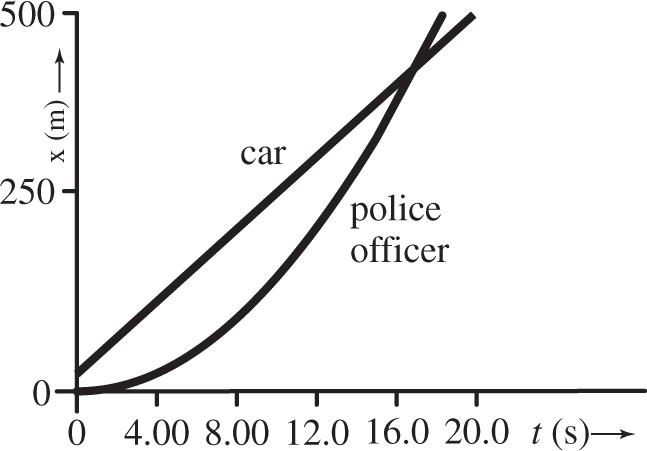

2.1 We assume that you are approximately 2 m tall and that the nerve impulse travels at uniform speed. The elapsed time is then
the distance light travels in
Comparing the result of part (a) to the diameter of the Earth, DE, we find
2.3 Distances traveled between pairs of cities are
Δx1 = v1(Δt1) = (80.0 km/h)(0.500 h) = 40.0 km
Δx2 = v2(Δt2) = (100.0 km/h)(0.200 h) = 20.0 km
Δx3 = v3(Δt3) = (40.0 km/h)(0.750 h) = 30.0 km
Thus, the total distance traveled is Δx = (40.0 + 20.0 + 30.0) km = 90.0 km, and the elapsed time is Δt = 0.500 h + 0.200 h + 0.750 h + 0.250 h = 1.70 h
(a) v = Δx Δt = 90.0 km 1.70 h = 52.9 km /h
(b) Δx = 90.0 km (see above)
2.4 (a) The player runs 100 yards from his own goal line to the opposing team’s goal line. Then he runs an additional 50 yards back to the fiftyyard line, all in 18.0 s. Substitute values into the definition of average speed to find
Average speed = path length elapsed time = 100 yards + 50 yards 18.0 s = 8.33 yards/s
(b) After returning to the fifty-yard line, the player’s displacement is Δx = xf xi = 50.0 yards 0 yards = 50.0 yards. Substitute values into the definition of average velocity to find
© 2018 Cengage Learning. All Rights Reserved. May not be scanned, copied or duplicated, or posted to a publicly accessible website, in whole or in part.
yards/s
2.5
(a) Boat A requires 1.0 h to cross the lake and 1.0 h to return, total time
2.0 h. Boat B requires 2.0 h to cross the lake at which time the race is over. Boat A wins, being 60 km ahead of B when the race ends.
(b) Average velocity is the net displacement of the boat divided by the total elapsed time. The winning boat is back where it started, its displacement thus being zero, yielding an average velocity of zero .
2.6 The average velocity over any time interval is

2.9 The plane starts from rest (v0 = 0) and maintains a constant acceleration of a = +1.3 m/s2. Thus, we find the distance it will travel before reaching the required takeoff speed (v = 75 m/s), from
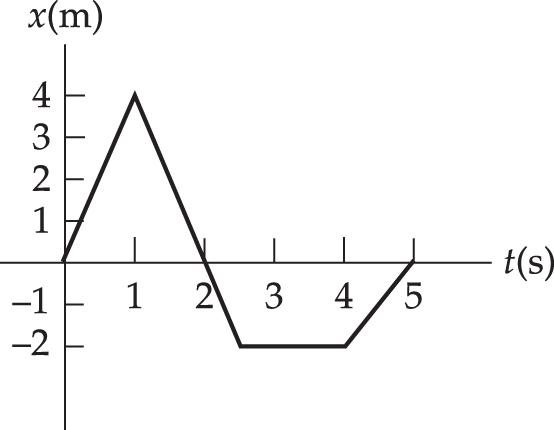
Since this distance is less than the length of the runway, the plane takes off safely.
2.10 (a) The time for a car to make the trip is t =
. Thus, the difference in the times for the two cars to complete the same 10 mile trip is
(b) When the faster car has a 15.0 min lead, it is ahead by a distance equal to that traveled by the slower car in a time of 15.0 min. This distance is given by Δx1 = v1(Δt) = (55 mi/h)(15 min)
The faster car pulls ahead of the slower car at a rate of
Thus, the time required for it to get distance Δx1 ahead is
Finally, the distance the faster car has traveled during this time is
after starting from rest is
2.14
(a) At the end of the race, the tortoise has been moving for time t and the hare for a time t 2.0 min = t 120 s. The speed of the tortoise is vi = 0.100 m/s, and the speed of the hare is vh = 20 vt = 2.0 m/s. The tortoise travels distance xt, which is 0.20 m larger than the distance xh traveled by the hare. Hence, xt = xh + 0.20 m
which becomes vtt = vh(t 120 s) + 0.20 m
or (0.100 m/s)t = (2.0 m/s)(t 120 s) + 0.20 m
This gives the time of the race as t = 1.30 × 102 s
(b) xt = vtt = (0.100 m/s)(1.3 × 102 s) = 13 m
2.15 The maximum allowed time to complete the trip is
The time spent in the first half of the trip is
Thus, the maximum time that can be spent on the second half of the trip is
© 2018 Cengage Learning. All Rights Reserved. May not be scanned, copied or duplicated, or posted to a publicly accessible website, in whole or in part.
s = 10.5
and the required average speed on the second half is
2.16 (a) From the first kinematic equation with v0 = 0, t = 7.00 × 10-7 s, and a = 5.30 × 107 m/s2, the maximum speed is v
2.17 The instantaneous velocity at any time is the slope of the x vs. t graph at that time. We compute this slope by using two points on a straight segment of the curve, one point on each side of the point of interest.

(b) We will use a 0.400 s interval centered at t = 400 s. We find at t = 3.80 s, x = 60.2 m and at t = 4.20 s, x = 76.6 m. Therefore,
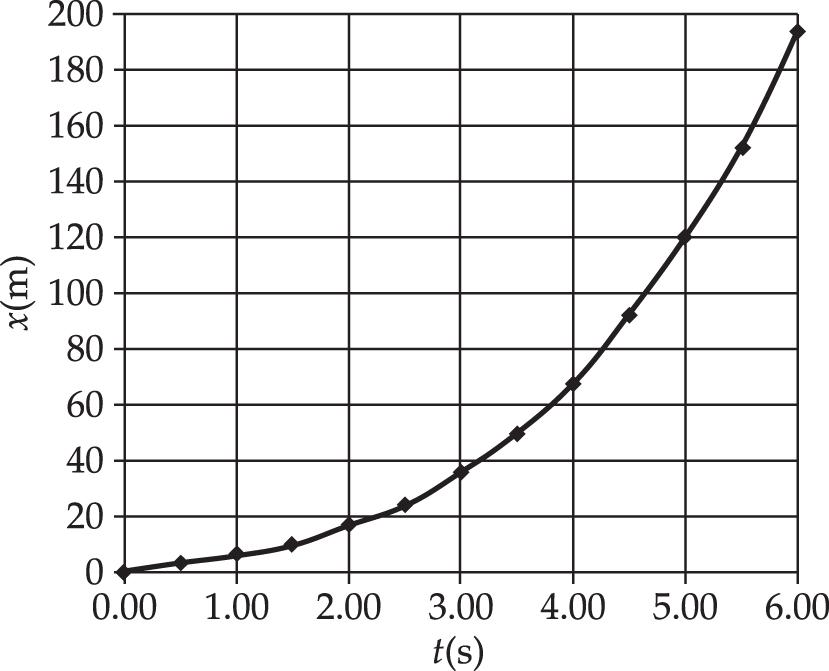
Using a time interval of 0.200 s, we find the corresponding values to be: at t = 3.90 s, x = 64.0 m and at t = 4.10 s, x = 72.2 m. Thus,
=
For a time interval of 0.100 s, the values are: at t = 3.95 s, x = 66.0 m, and at
=
s, x = 70.1 m. Therefore,
(c) At t = 4.00 s, x = 68.0 m. Thus, for the first 4.00 s,
This value is much less than the instantaneous velocity at t = 4.00 s.
2.19 Choose a coordinate axis with the origin at the flagpole and east as the positive direction. Then, using x = x0 + v 0 t 1 2 at 2 with a = 0 for each runner, the x-coordinate of each runner at time t is
xA = 4.0 mi + (6.0 mi/h)t and xB = 3.0 mi + ( 5.0 mi/h)t
When the runners meet, xA = xB giving 4.0 mi + (60 mi/h)t = 3.0 mi + ( 5.0 mi/h)t or (6.0 mi/h + 5.0 mi/h)t = 3.0 mi + 4.0 mi. This gives the elapsed time when they meet as t = (7.0 mi)/(11.0 mi/h) = 0.64 h. At this time,
xA = xB = 0.18 mi. Thus, they meet 0.18 mi west of the flagpole .
2.20 From the figure below, observe that the motion of this particle can be broken into three distinct time intervals, during each of which the particle has a constant acceleration. These intervals and the associated accelerations are 0 ≤ t ≤ 10.0 s, a = a1 = +2.00 m/s2 10 ≤ t ≤ 15.0 s, a = a2 = 0
© 2018 Cengage Learning. All Rights Reserved. May not be scanned, copied or duplicated, or posted to a publicly accessible website, in whole or in part.
(a)
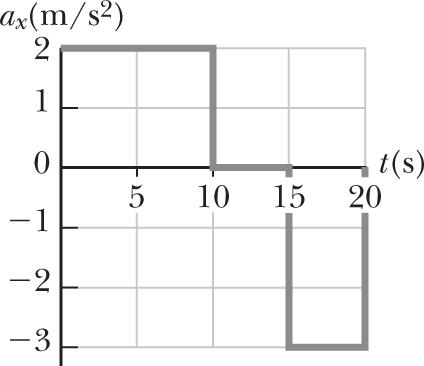
Thus, the total distance traveled in the first 20.0 s is
2.21 We choose the positive direction to point away from the wall. Then, the initial velocity of the ball is vi = 25.0 m/s and the final velocity is vf = +22.0 m/s. If this change in velocity occurs over a time interval of
= 3.50 ms (i.e., the interval during which the ball is in contact with the wall), the average acceleration is
2018
(b)
(c) From t = 0 to t = 20 s,
(ii) At any instant, the instantaneous acceleration equals the slope of the line tangent to the v vs. t graph at that point in time.
(a) At t = 2.0 s, the slope of the tangent line to the curve is 0 .
(b) At t = 10 s, the slope of the tangent line is 1.6 m/s2
(c) At t = 18 s, the slope of the tangent line is 0
Learning.
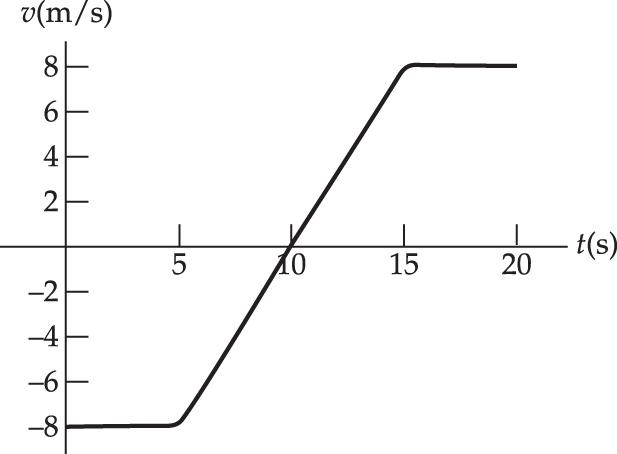
(b)
2.26 As in the algebraic solution to Example 2.5, we let t represent the time the trooper has been moving.

The curves intersect at t = 16.9 s
Apply
© 2018 Cengage Learning. All Rights Reserved. May not be scanned, copied or duplicated, or posted to a publicly accessible website, in whole or in part.
The known quantities are initial velocity, final velocity, and displacement. The kinematics equation that relates these quantities to
, we find that

(b) In this case, the object moves in the same direction for the entire time interval and the total distance traveled is simply the magnitude or absolute value of the displacement. That is,
(c) Here, vi = 6.00 m/s and vf = 12.0 m/s, and we find
(d) In this case, the object initially slows down as it travels in the negative x-direction, stops momentarily, and then gains speed as it begins traveling in the positive x-direction. We find the total distance traveled by first finding the displacement during each phase of this motion. While coming to rest (vi = 6.00 m/s, vf = 0),
After reversing direction (vi = 0 m/s, vf = 12.0 m/s),
Note that the net displacement is Δx = Δx1 + Δx2 = 4.50 m + 18.0 m = 13.5 m, as found in part (c) above. However, the total distance traveled in this case is
(b) From a = Δv/Δt, the required time is
(c) Yes. For uniform acceleration, the change in velocity Δv generated in time Δt is given by Δv = a(Δt). From this, it is seen that doubling the length of the time interval Δt will always double the change in velocity Δv. A more precise way of stating this is: “When acceleration is constant, velocity is a linear function of time.”
2.34 (a) The time required to stop the plane is
(b) The minimum distance needed to stop is
Thus, the plane requires a minimum runway length of 1.00 km. It cannot land safely on a 0.800 km runway.
2.35 We choose x = 0 and t = 0 at the location of Sue’s car when she first spots the van and applies the brakes. Then, the initial conditions for Sue’s car are x0S = 0 and v0S = 30.0 m/s. Her constant acceleration for aS = 2.00 m/s2
The initial conditions for the van are x0V = 155 m, v0V = 5.00 m/s, and its constant acceleration is aV = 0. We then use Δx = x x0 = v 0 t + 1 2 at 2 to write an equation for the x-coordinate of each vehicle for t ≥ 0. This gives Sue’s
In order for a collision to occur, the two vehicles must be at the same location (i.e., xS = xV). Thus, we test for a collision by equating the two equations for the x-coordinates and see if the resulting equation has any real solutions.
2018 Cengage Learning. All Rights Reserved. May not be scanned, copied or duplicated, or posted to a publicly accessible website, in whole or in part.
Using the quadratic formula yields
The solutions are real, not imaginary, so a collision will occur . The smaller of the two solutions is the collision time. (The larger solution tells when the van would pull ahead of the car again if the vehicles could pass harmlessly through each other.) The x-coordinate where the collision occurs is given by
2.36 The velocity at the end of the first interval is
This is also the constant velocity during the second interval and the initial velocity for the third interval. Also, note that the duration of the second interval is t2 = (2.05 min)(60.0 s/1 min) = 123 s. (a) From Δx =
the total displacement is
2.37 Using the uniformly accelerated motion equation
for the
is obviously wrong. The source of the error is found by computing the time required for the train to come to rest. This time is
Thus, the train is slowing down for the first 20 s and is at rest for the last 20 s of the 40 s interval.
The acceleration is not constant during the full 40 s. It is, however, constant during the first 20 s as the train slows to rest. Application of
This is also the initial velocity for the braking period.
(a) After braking, vf = v + atbrake = 7.5 m/ s + ( 2.0 m/s2)(3.0
(b) The total distance traveled is
2.40 For the acceleration period, the parameters for the car are: initial velocity
= via = 0, acceleration = aa = a1, elapsed time = (Δt)a = t1, and final velocity = vfa. For the braking period, the parameters are: initial velocity = vib = final velocity of acceleration period = vfa, acceleration = ab = a2, and elapsed time =
(a) To determine the velocity of the car just before the brakes are engaged, we apply vf =
to the acceleration period and find
(b) We may use
to determine the distance traveled during the acceleration period (i.e., before the driver begins to brake). This gives
(c) The displacement occurring during the braking period is
Thus, the total displacement of the car during the two intervals combined is
2.41 The time the Thunderbird spends slowing down is
The time required to regain speed after the pit stop is
Thus, the total elapsed time before the Thunderbird is back up to speed is
During this time, the Mercedes has traveled (at constant speed) a distance
and the Thunderbird has fallen behind a distance
2.42 The initial bank account balance is xi = $1.0 × 104 (to two significant figures) and the bank account is empty when xf = 0 with a change of Δx =
× 104). Use
with v0 = 0 and a = 2.5 × 102 $/month to find the time, t:
2.43 (a) Take t = 0 at the time when the player starts to chase his opponent. At this time, the opponent is distance d = (12 m/s)(30 s) = 36 m in front of the player. At time t > 0, the displacements of the players from their initial positions are
When the players are side-by-side, Δxplayer = Δxopponent + 36 m [3]
Substituting Equations [1] and [2] into Equation [3] gives
Applying the quadratic formula to this result gives
© 2018 Cengage Learning. All Rights Reserved. May not be scanned, copied or duplicated, or posted to a publicly accessible website, in whole or in part.
which has solutions of t = 2.2 s and t = +8.2 s. Since the time must be greater than zero, we must choose t = 8.2 s as the proper answer.
2.44 The initial velocity of the train is v
and the final velocity is v = 16.4
The time required for the 400 m train to pass the crossing is found
(b) The time to reach the highest point is
(c) The time required for the ball to fall 31.9 m, starting from rest, is found
(d) The velocity of the ball when it returns to the original level (2.55 s
after it starts to fall from rest) is
2.46 We take upward as the positive y-direction and y = 0 at the point where the ball is released. Then, v0y = 8.00 m/s, ay = g = 9.80 m/s2, and Δy =
, the velocity of the ball just before it hits the ground is
when the ball reaches the ground. From
ayt gives the elapsed time as
2.47 (a) The velocity of the object when it was 30.0 m above the ground can be determined by applying Δy =
+
at 2 to the last 1.50 s of the fall.
(b) The displacement the object must have undergone, starting from rest, to achieve this velocity at a point 30.0 m above the ground is given by
+ 2 a ( Δy ) as
The total distance the object drops during the fall is then
2.48 (a) Consider the rock’s entire upward flight, for which v0 = +7.40 m/s,
vf = 0, a = g = 9.80 m/s2, yi = 1.55 m, (taking y = 0 at ground level), and yf = hmax = maximum altitude reached. Then applying
2 + 2 a ( Δy ) to this upward flight gives
Solving for the maximum altitude of the rock gives
Since hmax > 3.65 m (height of the wall), the rock does reach the top of the wall .
(b) To find the velocity of the rock when it reaches the top of the wall, we use v f 2 = vi 2 + 2 a ( Δy ) and solve for vf when yf = 3.65 m (starting with vi = +7.40 m/ s at yi = 1.55 m). This yields
(c) A rock thrown downward at a speed of 7.40 m/s (vi = 7.40 m/s) from the top of the wall undergoes a displacement of (Δy) = yf yi =
before reaching the level of the attacker. Its velocity when it reaches the attacker is
so the change in speed of this rock as it goes between the 2 points located at the top of the wall and the attacker is given by
(d) Observe that the change in speed of the ball thrown upward as it went from the attacker to the top of the wall was
The two rocks do not undergo the same magnitude speed change.
The rocks have the same acceleration, but the rock thrown downward has a higher average speed between the two levels, and is accelerated over a smaller time interval.
2.49 The velocity of the child’s head just before impact (after falling a distance of 0.40 m, starting from rest) is given by v
If, upon impact, the child’s head undergoes an additional displacement
Δy = h before coming to rest, the acceleration during the impact can be
The negative sign tells us that the bag is moving downward and the magnitude of the velocity gives the speed as 21.1 m/s
(b) The displacement of the mailbag after 2.00 s is
During this time, the helicopter, moving downward with constant velocity, undergoes a displacement of
The distance separating the package and the helicopter at this time is then
After 2.00 s, the velocity of the mailbag is
In this case, the displacement of the helicopter during the 2.00 s interval is
Meanwhile, the mailbag has a displacement of
2.51
The distance separating the package and the helicopter at this time is then
(a) From the instant the ball leaves the player’s hand until it is caught, the ball is a freely falling body with an acceleration of
(b) At its maximum height, the ball comes to rest momentarily and then begins to fall back downward. Thus,
= 0 .
(c) Consider the relation
g. When the ball is at the thrower’s hand, the displacement is
= 0, giving
This equation has two solutions, t = 0, which corresponds to when the ball was thrown, and t = 2v0/g corresponding to when the ball is caught. Therefore, if the ball is caught at t = 2.00 s, the initial velocity must have been
(d) From v 2 = v 0 2 + 2 a ( Δy ) , with v = 0 at the maximum height,
2.52 (a) Let t = 0 be the instant the package leaves the helicopter, so the package and the helicopter have a common initial velocity of vi = v0 (choosing upward as positive).
At times t > 0, the velocity of the package (in free-fall with constant acceleration ap = g) is given by v = vi + at as vp = v0 gt = (v0 + gt) and speed = |vp| = v0 + gt.
(b) After an elapsed time t, the downward displacement of the package from its point of release will be
and the downward displacement of the helicopter (moving with constant velocity, or acceleration ah = 0) from the release point at this time is
The distance separating the package and the helicopter at this time is then
